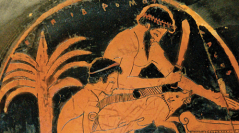

 Anthropozoologica
55 (6) - Pages 95-106
Anthropozoologica
55 (6) - Pages 95-106In Ancient Greece, the pig and the boar, though they wore the same names in the language, appear to be very different animals. Whereas the first one is stuck in a domestic area, the second one, on the contrary, shows its full power and combativity in the wild world. Its temper allows it to become a true model of virile virtue, which is particularly pregnant in the epic and remains important in the whole Greek literature. The pig’s image is very successful too but in a very different register; while the boar founds its place in the heroic sphere, the pig tends to be related to debauchery. In this article, from some extracts of Aristotle’s History of Animals, we aim to understand in what way the popular images linked to these animals can play a role in the scientist’s work. In order to get a global vision of the images attached to the boar, we will rely in particular on Homer’s works.
Boar, pig, Aristotle, Homer, symbols.